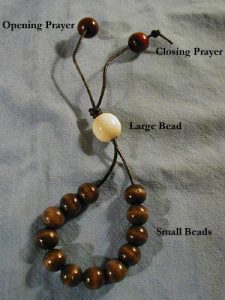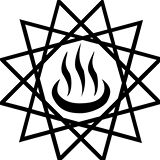A Garland for Zeus: Modern Prayer Bead Devotions
by Drew Campbell
Introduction
As far as I know, the ancient Greeks did not use beads or knots to count set prayers, although this practice has long been a part of a number of different religions (e.g., Roman Catholic rosaries, Buddhist malas, and Orthodox prayer ropes). So the information on this page should be considered an innovation rooted not in Hellenic historical precedent, but in modern example and personal need.
The wording of the prayers is traditional, however. Because prayer bead devotions rely on the repetition of familiar words for their effectiveness, I’ve chosen prayers from the ancient corpus that I know and love. In each case, they have been condensed down from longer hymns and prayers.
The form the beads should take posed a problem. I didn’t want to adapt the Catholic rosary (although some polytheists have done so) or the Orthodox prayer rope, because I felt that the cultural associations were just too weighty to make such borrowings effective for me. Instead, I based my beads on a secular, but culturally Greek, model: komboloi, or worry beads.
I made my set from inexpensive wood beads strung on a leather thong (all from a craft store). The total cost of the materials I purchased was under $10, and would easily make a dozen sets of beads, making this a great project for a Demos or other worship group, or for parents and children to do together. Any kind of beads and cord that pleased the individual could be used; materials appropriate to the deity to be honored would be especially meaningful.
I used twelve small beads to symbolize the twelve Olympians, but any number that relates to the deity in question would work (e.g., seven for Apollon). Actual komboloi have various numbers of beads depending on the design; if you have a set you like, I wouldn’t worry too much about the exact number of beads.

How to Use the Beads
The prayers can be said verbally or mentally, depending on your comfort level with verbal prayer and your surroundings.
Hold one of the smaller beads at the end of the set between your fingers and say the opening prayer. Then move your fingers to the large bead and say the prayer for that bead. Move on to the small beads and repeat the appropriate prayer once for each bead. Then move to the large bead again and repeat that prayer. Finally, move to the other end bead and say the closing prayer. Repeat the cycle as desired.
The Prayers
- Opening Prayer
I will sing of Zeus, noblest and greatest of the gods!
Be gracious, all-seeing son of Cronos, most excellent and great. [1]
- Large Bead
Much-honored Zeus, indestructible Zeus, I lay before you this prayer.
Hear me, O many-faced one, and grant me unblemished health, divine peace, and riches and glory without blame. [2]
- Small Beads
Zeus was the first, Zeus last, the lightning’s lord,
Zeus head, Zeus center, all things are from Zeus. [3]
- Closing Prayer
Gentle Zeus, who gives birth and livelihood to mortals
You possess the keys to joy and sorrow as well.
So, O pure and blessed one, drive painful cares away,
And bring a glorious, sweet, and noble end to life. [4]
Sources
[1] Excerpted from the Homeric Hymn to the Son of Cronos, Most High, in: Hesiod, Homeric Hymns, and Homerica, trans. Hugh G. Evelyn-White (Cambridge, MA: Harvard University Press, 1936), pp. 448-449.
[2] Excerpted from the Orphic Hymn to Zeus, in: Apostolos N. Athanassakis, The Orphic Hymns: Text, Translation and Notes (Atlanta: Scholars Press, 1977), pp. 24-25.
[3] From Porphyry, “On Images,” trans. Edwin Hamilton Gifford, http://classics.mit.edu/Porphyry/images.shtml.
[4] Excerpted from the Orphic Hymn to Daimon, in: Apostolos N. Athanassakis, The Orphic Hymns: Text, Translation and Notes (Atlanta: Scholars Press, 1977), pp. 96-97.
Acknowledgements
I would like to thank the members of the Hellenic Paganism forum at Delphi, especially Caroline Julian, and the Rev. Laeaurra Flamehawk-Mitchell for their inspiration, and my wife, Anne, for her help with the digital image on this page. I was also inspired by Ceisiwr Serith’s discussion of litanies and rosaries in his Book of Pagan Prayer. -DC
Written by Drew Campbell, ©Hellenion. All rights reserved, contact us for permission.t © 2001-2002, by Andrew Campbell
